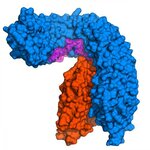Ecology & Zoology

Researchers wondered whether bed bugs preferred certain colors for their hiding places, so they did some testing in the lab.
The tests consisted of using small tent-like harborages that were made from colored cardstock and placed in Petri dishes. A bed bug was then placed in the middle of the Petri dish and given ten minutes to choose one of the colored harborages. A few variations of the test were also conducted, such as testing bed bugs in different life stages, of different sexes, individual bugs versus groups of bugs, and fed bugs versus hungry bugs.
The results in the Journal of Medical…

A typical mouse laboratory is kept between 20 and 26 degrees C, but if the mice had it their way, it would be a warm 30 degrees C. While the mice are still considered healthy at cooler temperatures, they expend more energy to maintain their core temperature, and evidence is mounting that even mild chronic cold stress is skewing results in studies of cancer, inflammation, and more.
There are multiple reasons to keep a mouse lab cool. Researchers don gowns, gloves, and masks to work with the animals, which makes the lower temperature more comfortable and also cuts down on the smell. The…

During their life, plants constantly renew themselves. They sprout new leaves in the spring and shed them in the fall. No longer needed, damaged or dead organs such as blossoms and leaves are also cast off by a process known as abscission. By doing so, plants conserve energy and prepare for the next step in their life cycle.
But how does a plant know when it is the right time to get rid of unnecessary organs? It is regulated by receptor proteins located at the surface of specific cells that form a layer around the future break point. When it is time to shed an organ, a small hormone binds to…

Illuminating fishing nets is a cost-effective means of dramatically reducing the number of sea turtles getting caught and dying unnecessarily, conservation biologists at the University of Exeter have found.
Dr Jeffrey Mangel, a Darwin Initiative research fellow based in Peru, and Professor Brendan Godley, from the Centre for Ecology and Conservation at the University's Penryn Campus, were part of a team of researchers who found that attaching green battery powered light-emitting diodes (LED) to gillnets used by a small-scale fishery reduced the number of green turtle deaths by 64 per cent,…

Thanks to government mandates and ongoing subsidies, wind energy has become more popular, and one impact of large-scale wind energy development has been widespread mortality of bats. A new study tracks down the origin of bats killed by wind turbines in the Appalachian region in hopes of better understanding the risks to affected populations.
Wind-energy sites along the forested ridgelines of the Appalachian Mountains have some of the highest bat mortality rates in the world. The hoary bat (Lasiurus cinereus) and eastern red bat (Lasiurus borealis) comprise the majority of the turbine-…
As the deadly bat disease called white-nose syndrome continues to spread across North America, scientists are studying bats in China to understand how they are able to survive infections with the same fungus that has wiped out millions of North American bats.
By comparing disease dynamics in North American and Asian bat populations, researchers have found evidence that Asian bat species have much lower levels of infection than North American species and therefore are resistant to the fungus. The study, published March 9, 2016 in Proceedings of the Royal Society B, also suggests that some…

Cat owners tare familiar with their pets’ individual personalities, habits and preferences, and they can tell when the behavior is different than normal, but understanding what these changes mean can be much more difficult.
Veterinarians have identified 25 behavioral signs displayed by cats which could indicate that they are suffering pain, which could ultimately reduce suffering by leading to faster diagnosis of problems and illnesses. The researchers undertook the project as part of a larger initiative aimed at identifying the expression of pain in cats, focusing on the face. This initial…
Horses have been shown to be able to distinguish between angry and happy human facial expressions, according to psychologists who studied how 28 horses reacted to seeing photographs of positive versus negative human facial expressions.
The horses were recruited from five riding or livery stables in Sussex and Surrey, UK, between April 2014 and February 2015. They were shown happy and angry photographs of two unfamiliar male faces. The experimental tests examined the horses' spontaneous reactions to the photos, with no prior training, and the experimenters were not able to see which…

The belief by Western elites that ancient people lived in some sort of harmony with the land, a belief popular for the last century, has been punctured again.
Instead, evolution continues to rule - rather than some sort of harmonic balance only the species that get to an area and are fittest to survive actually do. That is what natural really is.
The latest study to drive home that point is the 500-pound flightless bird known as Genyornis newtoni. G. newtoni was nearly 7 feet tall and appears to have lived in much of Australia prior to the establishment of humans on the continent 50,000…

DNA profiling reveals grey squirrels are not as good invaders as we think, and that humans played a much larger role in spreading them through the UK.
Grey squirrels were imported to the UK from the 1890s onwards, and the traditional view is that they spread rapidly across the UK due to their ability cope with new landscapes. Different populations of grey squirrels were thought to have interbred into a 'supersquirrel' that was better able to adapt and spread.
However, new research shows greys may not be as hardy as once thought, and were helped much more by humans in their conquest of the…